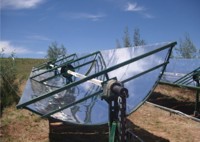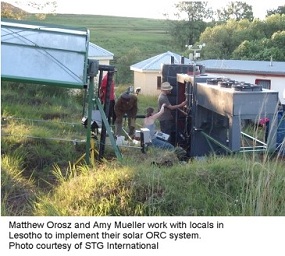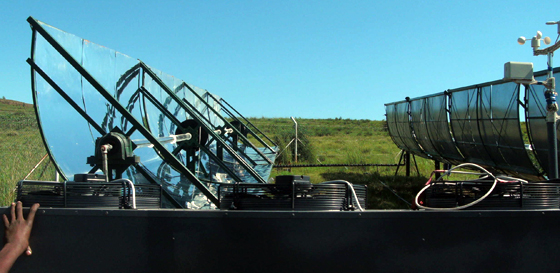Power to the people --- and heat as well
 In some isolated clinics in parts of Africa, the electricity needed to power lights and medical devices is generated by expensive imported diesel fuel; the water supply can be so cold in winter that health workers can’t even wash their hands properly. But a startup company established by a team of MIT students and alumni aims to change that.
In some isolated clinics in parts of Africa, the electricity needed to power lights and medical devices is generated by expensive imported diesel fuel; the water supply can be so cold in winter that health workers can’t even wash their hands properly. But a startup company established by a team of MIT students and alumni aims to change that.The patented technology they developed uses a mirrored parabolic trough to capture sunlight, heating fluid in a pipe along the mirror’s centerline. This fluid then powers a sort of air conditioner in reverse: Instead of using electricity to pump out cold air on one side and hot air on the other, it uses the hot fluid and cold air to generate electricity. At the same time, the hot fluid can be used to provide heat and hot water - or, by adding a separate chiller stage, to produce cooling as well.
 A prototype of the system has been installed at a small clinic in the southern African nation of Lesotho; next year, the MIT team plans to have five fully operational systems installed in isolated clinics and schools there for field-testing.
A prototype of the system has been installed at a small clinic in the southern African nation of Lesotho; next year, the MIT team plans to have five fully operational systems installed in isolated clinics and schools there for field-testing.The key element of the system - a device called a scroll expander, used to convert the heat to power - is described in a paper to be published in the ASME Journal of Engineering for Gas Turbines and Power.
Matthew Orosz MEng, the lead author of the paper, says the idea for the project began years ago, when he spent two years working in a village in Lesotho as a Peace Corps volunteer - with no access to electricity or hot water. There are some 30,000 clinics and 60,000 schools around the world that similarly lack access to electricity but have sufficient sunshine to meet their power needs, Orosz says; he returned to MIT determined to do something about that.
Working with fellow student Amy Mueller, their thesis advisor Harold Hemond, the William E. Leonhard Professor of Engineering at MIT, and others, Orosz set up a nonprofit company called Solar Turbine Group (now known as STG International) to develop the solar technology that he envisioned as a practical alternative for these off-the-grid facilities.
Today, Orosz explains, there are only two viable options to provide electricity for such places: a solar photovoltaic (PV) array or a diesel generator. Both are somewhat less expensive to install than his company’s solar trough system, but when the costs of replacement parts and fuel are factored in, he estimates the solar trough system will be substantially cheaper over its lifetime.
People think of Africa as uniformly hot, Orosz says, but in fact Lesotho is temperate and has cold winters with occasional snowfall - making heat and hot water a significant bonus. “We’ve had nurses tell us they avoid washing their hands in the winter, because the water is so cold,” he says. “So hot water is very welcome.”

The pilot system, which Orosz and his colleagues started to assemble at Lesotho’s Matjotjo Village Health Clinic in 2008, provided the initial proof of principle, though it took years to get all the parts working properly in that remote location. While they were able to demonstrate the successful operation of their heat-powered generator - a system called an organic Rankine cycle (ORC) engine - the system required a skilled operator to adjust the temperatures, pressures and voltages as conditions changed.
Since then, the STG team has developed a sophisticated computerized control system, allowing the system to run virtually hands-free. Once that system is installed, the only routine maintenance required is washing the huge mirrors every six months or so.
Right now the STG team, which also includes Elizabeth Wayman ‘04, and Brian Urban is working on a test installation at Eckerd College in Florida to test the new control system.
The clinic in Lesotho, now closed for renovations, is expected to reopen early next year, when the team plans to return to the site and begin full-time operations with the newly automated setup. Over the course of the year, they plan to install four more systems at other schools and clinics in that country, with help from Lesotho’s ministries of health and education and three local engineers who are members of the STG team.
The team hopes to create a local source of jobs and revenues; the systems will be built, owned and operated by local companies set up for that purpose, Orosz says.
Daniel Kammen, a professor of energy at the University of California at Berkeley and co-director of the Berkeley Institute of the Environment, who is not involved in this project, says, “There are a number of exciting solar thermal technology options, including but not limited to that being tested by STG International. All hold promise.”
He adds that “the challenge is not in the basic hardware, but in sustainable, viable field operation” - the area that STG is focusing on for its tests next year. “That is an excellent first step,” he says, “but the jury is out until these facilities function in the field, operated by the local communities.”
Over the years, STG’s project has won numerous awards and grants to help develop the technology, the financing systems and the supply chains using local materials and labor. An initial prize from the MIT IDEAS competition was followed by a grant from the World Bank, a Conoco Philips Energy prize, an Echoing Green Fellowship, and others. The team’s ongoing research and development work will be aided by grants from the MIT Energy Initiative, the National Renewable Energy Laboratory and the government of India.
You can return to the main Market News page, or press the Back button on your browser.

